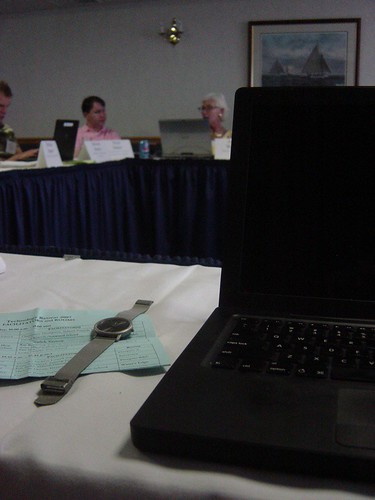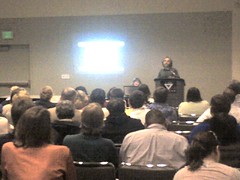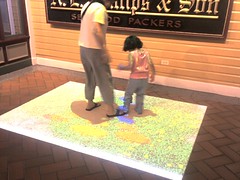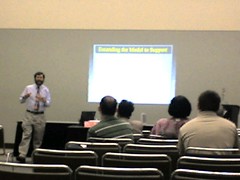 I’ll be writing this blog over the day, sharing some of the things I learn, hear, get validated, and some of the fun and energy of this very interesting conference. It is first important to note that although they don’t call it this, the AIMS retreat is an unconference event. All of the breakout sessions are intended to be conversations. I just finished a session on Web 2.0, for which I spent about ten minutes introducing the concept and the rest of the time presiding over conversations.
I’ll be writing this blog over the day, sharing some of the things I learn, hear, get validated, and some of the fun and energy of this very interesting conference. It is first important to note that although they don’t call it this, the AIMS retreat is an unconference event. All of the breakout sessions are intended to be conversations. I just finished a session on Web 2.0, for which I spent about ten minutes introducing the concept and the rest of the time presiding over conversations.
I have said before that having this conversation with independent school educators is quite different from where we go when exploring the issues with public schoolers. Although security is a huge issue for private schools, and mention of it came up several times during the session, just about all of the conversation was about instructional applications.
One of the primary issues discussed was how to get kids to converse on their blogs in a deep way. There were lots of suggestions, but the consensus seemed to be that when kids write as a conversation among themselves, for themselves, they seem more willing to take their writing to deeper levels. If, on the other hand, they are working on what is seen as a teacher assignment, then the tendency is to write what they think the teacher wants to read — and that is usually more shallow in depth.
Michelle Moore is back, feeling a bit better, and she is doing an overview of Moodle. She’s doing an excellent job of describing the various modules with examples. I’m sold. She’s using a Moodle course called Welcome to Moodle from Remote-Learner.Net. You can click here to go directly to the course. However, it may ask for a login. You can select guest login.
Michelle is amazingly good at using a remote mouse control. I’m very impressed.
Now this is interesting. They are starting to talk about Moodle and curriculum mapping, ways that Moodle might be tied to a schools curriculum map, or curriculum map tied to teacher’s Moodle resources. I do not understand the environment enough to understand where they are going, but there is definitely some excitement in the room.
I’ve moved to a session called, Back to the Future: Information Landscape: Past, Present, and Future. I wish I could sit in all of these sessions, and that I could have started with this one. These folks (mostly librarians) are talking my language. They are talking about research assignments, and a young man (Fred Haller) states that it is essential that a research question be crafted that can not be easily found with a single search of Wikipedia or even Encyclopedia Britannica.
The very important question has been asked. What’s going to happen to the library space? There was a lot of talk about the tactile nature of books – that people still want to use books. But Fred, again, held up his tablet PC (a lot of Tablets at this conference) and suggested that the form factor still has some evolving to do. Will there be a device in the future (near future?) that truly replaces the book as the desirable way to read? If so, what happens to the library space? I suggested that I had heard, during their conversations, a lot about reading and research. But I’d not heard so much about processing information and compellingly communicating it — other parts of the literacy spectrum. I then suggested that they think about encompassing all elements of literacy and turn their libraries into places where people come not only to consume contention, but also to produce it.
I final question from the presider at the end. What about copyright. It didn’t get talked about here, but it is something that must continue to be thought about and become a part of conversations.
It’s the afternoon now, and I’m in a session on distance learning. But I was reminded, during a lunch conversation, how difficult it is (impossible) to address the needs of education, without also considering much much larger issues of society. Just thought I would drop that in here.
There is a lot of talk about MIT and Stanford — and that the University of Maryland is now offering online courses available to high school students. An initial concern among the group is, “do I have enough bandwidth?” One participant said that the distance learning courses their students take are only text. Very little bandwidth is needed. Michelle Moore suggested later in the conversation that distance learning courses will likely become more media-rich with audio and video.
The session has become rather geeky, which everyone seems happy with. They’re here to learn what they need. I don’t understand a lick of it. Finally, someone has asked the question. Why? What problem(s) is distance learning solving for us?
I’ve moved to a session called, Splendor in the Class: Connected Students – How Much is Tool Much? This might be the central theme for my closing address. Connectedness! Why do we need to be connected? When do we need to be connected?
What is the need, among us tech savvy people, to always have our cell phones and Blackberrys available so that we do not miss anything?
An even more question to me is, “why do our children who seem to need to be connect, not consider themselves as tech-savvy?”
What occurred to me, as I was walking back to my room, is that so much of what we expected from the future has come to be entirely different. For instance, it’s not really big brother that we’ve come to worry about, but lots of little brothers. Also, at the same time that the world has become smaller, our personal worlds have become larger, and this is the reason, I think, for a need to be connected.
Because our world sense extends far beyond what we can see and hear. In order to feel a part of this larger world, we have to be connected to it, and this not truer for any group than educators. At the same time that the world has gotten smaller, our classrooms have gotten larger, our curriculum has gotten larger, the basic skills required to use information to accomplish goals (literacy) has gotten larger, our students’ individual frames of reference has gotten larger. It’s why it is so essential that our classrooms, our students, our curriculum, and our teachers must be connect.
It’s the next day, and one more session before my closing address. The session I’m attending is called “Don’t Bother Me Mom — I’m Learning!” after the book by Marc Prensky. Several of the attendees have their copies with them. The initial conversation involes our trying to determine if we are digital natives or digital immigrants. I think that you’re born a native or an immigrant. I once heard that “Technology is anything that was invented after you were born.” If this is true, then the best that we can do is to lose our accent.
A little later in the presentation a young man (self-proclaimed native) talked about a friend whose extended family plays a MMORPG every Sunday, and they live in different geographic locations. In this family, for a particular week, they think of their grandfather as someone who saved them from invading marauders last weekend.
 Yesterday’s post (And a Picture, Too), about the high school senior whose name and picture were included in her Charlotte Observer review of the movie, Fracture, generated a lot of conversation — especially for a Sunday. The responses sat pretty much on opposite ends of the issue’s spectrum, initially reporting dismay at the news paper
Yesterday’s post (And a Picture, Too), about the high school senior whose name and picture were included in her Charlotte Observer review of the movie, Fracture, generated a lot of conversation — especially for a Sunday. The responses sat pretty much on opposite ends of the issue’s spectrum, initially reporting dismay at the news paper 
 I’m at home, in my home town, in western piedmont North Carolina. I was just reading a movie review in the Charlotte Observer about Fractured, a suspence thriller that Brenda and I went to see last weekend, and thoroughly enjoyed.
I’m at home, in my home town, in western piedmont North Carolina. I was just reading a movie review in the Charlotte Observer about Fractured, a suspence thriller that Brenda and I went to see last weekend, and thoroughly enjoyed. 
 I’m sitting in a session being taught by Scott Osterweil, inventor of Zoombinis and director of the Education Arcade at MIT. The session is, of course, about games, and he just distinguished between the two far extremes of the game spectrum, from the gamer, who imply that we should just take kids out of classrooms, have them play games, and they learn what they need to know. The other end is obvious. The effect is too often, somthing that he calls Content Stuffers. You take a game concept, stuff content into it, and then expect players to learn. He shows a picture of “Grand Theft Calculus.”
I’m sitting in a session being taught by Scott Osterweil, inventor of Zoombinis and director of the Education Arcade at MIT. The session is, of course, about games, and he just distinguished between the two far extremes of the game spectrum, from the gamer, who imply that we should just take kids out of classrooms, have them play games, and they learn what they need to know. The other end is obvious. The effect is too often, somthing that he calls Content Stuffers. You take a game concept, stuff content into it, and then expect players to learn. He shows a picture of “Grand Theft Calculus.”
 The Change Process and How Schools Change With Technology with David Marcovitz. I was not originally coming to this session. It didn’t tap me on the shoulder when I was going through the program. But as I walked by the sign, saw it, read it, and I walked in.
The Change Process and How Schools Change With Technology with David Marcovitz. I was not originally coming to this session. It didn’t tap me on the shoulder when I was going through the program. But as I walked by the sign, saw it, read it, and I walked in.  I want to apologize to the owner of whoever’s house it is that I keep landing in, every time I try to teleport home in Second Life. I think that perhaps it wasn’t there when I first set that landmark. It’s the one just by my left hand, with the white roof.
I want to apologize to the owner of whoever’s house it is that I keep landing in, every time I try to teleport home in Second Life. I think that perhaps it wasn’t there when I first set that landmark. It’s the one just by my left hand, with the white roof.
 There were also a bunch of interesting ships in the harbor, including this replica of a Chesapeake Bay Pungy schooner. I guess that the most amazing sight, to me, was The
There were also a bunch of interesting ships in the harbor, including this replica of a Chesapeake Bay Pungy schooner. I guess that the most amazing sight, to me, was The  I’ll be writing this blog over the day, sharing some of the things I learn, hear, get validated, and some of the fun and energy of this very interesting conference. It is first important to note that although they don’t call it this, the AIMS retreat is an unconference event. All of the breakout sessions are intended to be conversations. I just finished a session on Web 2.0, for which I spent about ten minutes introducing the concept and the rest of the time presiding over conversations.
I’ll be writing this blog over the day, sharing some of the things I learn, hear, get validated, and some of the fun and energy of this very interesting conference. It is first important to note that although they don’t call it this, the AIMS retreat is an unconference event. All of the breakout sessions are intended to be conversations. I just finished a session on Web 2.0, for which I spent about ten minutes introducing the concept and the rest of the time presiding over conversations.